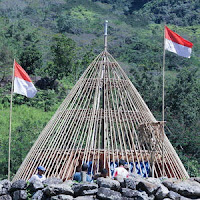Mbaru Niang is a traditional houses di Wae Rebo. One of the attractions of this village that is worldwide is the preserved traditional house in this village, Mbaru Niang. In the Manggarai language, Mbaru Niang means 'drum house'. Building this cone is built traditionally. It is called a drum house because one of the houses is used for storing sacred heirloom drums and gongs which are sacred media for communicating with ancestors.
Mbaru cone (kerucut) home in the village of Wae Rebo niang. Traditional house mbaru niang is very rare because only a few and only in villages remote indigenous Wae Rebo over the mountains.Mbaru niang cone with a height of about 15 meters. The roof of palm fiber or grass with a bamboo roof frame. The main poles using wood worok big and strong.Each mbaru niang housed six to eight families. Although not very large, the division of space in the mbaru niang show house functions as a living, to save the harvest, as well as to worship ancestors.At the first level is called lutur used as a place to live and hang out with family. The second level is called lobo form of an attic or a function for storing food and stuff everyday. The third level is called lentar to store seeds for food crops, such as corn, rice, and beans. The fourth level is called Lempa rae used to store food reserves that can be used when in an emergency due to crop failure. Five or top level called hekang code used to place offerings for ancestors.Wae Rebo Mbaru niang houses constructed by utilizing nature. Pole of wood, bamboo roof frame, roof of palm fiber.
Mbaru cone (kerucut) home in the village of Wae Rebo niang. Traditional house mbaru niang is very rare because only a few and only in villages remote indigenous Wae Rebo over the mountains.Mbaru niang cone with a height of about 15 meters. The roof of palm fiber or grass with a bamboo roof frame. The main poles using wood worok big and strong.Each mbaru niang housed six to eight families. Although not very large, the division of space in the mbaru niang show house functions as a living, to save the harvest, as well as to worship ancestors.At the first level is called lutur used as a place to live and hang out with family. The second level is called lobo form of an attic or a function for storing food and stuff everyday. The third level is called lentar to store seeds for food crops, such as corn, rice, and beans. The fourth level is called Lempa rae used to store food reserves that can be used when in an emergency due to crop failure. Five or top level called hekang code used to place offerings for ancestors.Wae Rebo Mbaru niang houses constructed by utilizing nature. Pole of wood, bamboo roof frame, roof of palm fiber.
Mbaru niang in Wae Rebo is a traditional house heritage hundreds of years ago. It is said that their ancestors bequeathed 7 pieces in Wae Rebo mbaru niang. However, due to improvements mbaru niang need to be expensive, in Wae Rebo mbaru niang slowly begins to break down with age.According
to the record of an anthropologist, Catherine Allerton who conduct
research in Wae Rebo: in the 1970's custom home in Wae Rebo is already
visible decay.

However, the uniqueness of the cone on top of the mountains are often shrouded in fog is very attractive to foreign tourists. The photos Wae Rebo village and traditional house mbaru niang spread around the world through postcards.Picture house mbaru niang a simple but unique charming Mr. Yoris Antar, a aristek from Jakarta. In 2008, armed with the picture postcard, Mr. Yoris and friends Wae Rebo village locate. Seeing
the authenticity mbaru niang as Indonesia's cultural richness is almost
extinct because of damage, and then move the Yoris Mr. Wae Rebo and
pioneered to raise funds for the preservation of this custom home.Houses mbaru niang cone is damaged beyond repair. Mbaru missing niang established again. In the misty mountains, now standing 7 home mbaru niang solid cone.
Mbaru niang the space division dlam terraced house mbara niang. Through
the restoration and redevelopment of the traditional house mbaru niang,
local residents especially the youth can learn how to build and
preserve this traditional house. This method is expected to be an example or inspire efforts pelestariakan intergenerational cultural wealth elsewhere. Efforts
to preserve the traditional houses in Wae Rebo mbaru niang by involving
the local community, it has recently received the highest award from
UNESCO.The
highest award Asia-Pacific Heritage Awards for Cultural Heritage
Conservation 2012 is given to indigenous Wae Rebo for his efforts to
preserve the traditional 7 home mbaru niang.Wae Rebo village is a remote village in Satar Lens, District Satarmese West Manggarai, Flores Island, East Nusa Tenggara, Indonesia.To go to this village, we had to walk strong. Traveling by car from Ruteng town can only get Denge village. The distance is about 80 kilometers and can be taken about 4 hours because the road winding. Of
Denge village, we have to walk through a small forest, crossing rivers
Wae Competition, and followed the path and climb up to get in Wae Rebo.Mbaru niang. Pearls in Wae Rebo village is simple, but worldwide.
Sumber : http://www.kidnesia.com/
Thus, hopefully useful. Don't forget to help support us by Follow or Ikuti this blog. Hope it is useful for all of us. :)

No comments:
Post a Comment